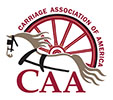Q. Is there any rule for placing the connection between the shafts and the sleigh? If so, please illustrate as plainly and briefly as possible.
A. The accompanying outline sketch plainly illustrates the answer to the above question. To determine the line of draft or traction, we must first find the center of gravity between the point of traction and extreme resistance. These are shown in the drawing.
D is the point of traction
B is the point of extreme resistance
A is the base line and bottom of runner
C is the front of the runner
E is top of the sleigh bottom
From the earth to the bottom of the tug-strap bearing, or bottom of the shaft at that point resting in the tug-strap, for the average horse, is about forty-two inches, or ranges from forty inches to forty-four inches. We take forty-two inches as the mean average, which is at D. The tug-strap on the average horse, in a majority of cases, is about eighty inches from the point of connection with the vehicle. Having located these two distances, draw a line from D to B, and obtain the line of connection C.
For economical purposes, the connection is usually, in this and most countries, made in front of the front posts, as at F – that is, for light sleighs or cutters. With the heavy and larger grades it is customary to put the jacks or connection on the nose-plates.
In Russia and Asiatic countries it is customary to make the connection with the runners only, using a long round pole for the purpose. The same custom prevailed in this country, with the purpose. The same custom prevailed in this country, with the freight sleighs and heavy sleighs, until about 1838.
From The Hub, June 1893
Also available in Horse Drawn Sleighs by Susan Green


